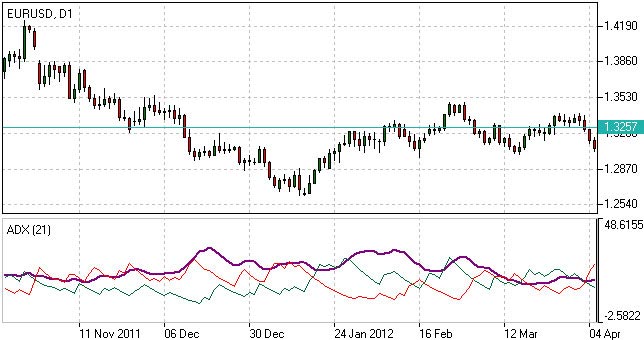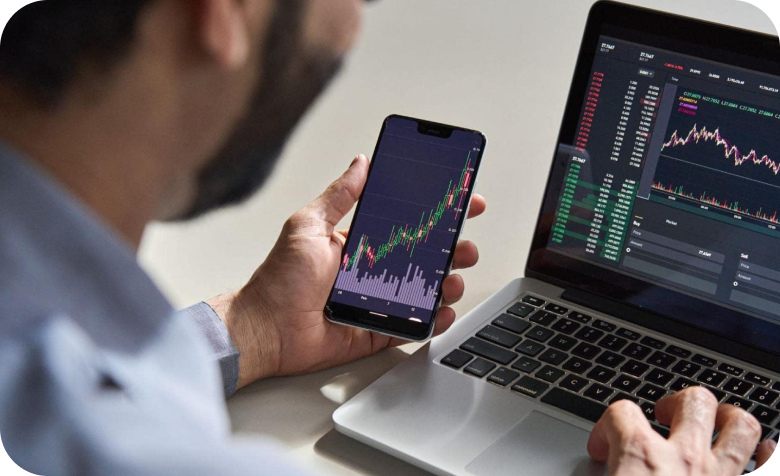- Education
- Forex Technical Analysis
- Technical Indicators
- Trend Indicators
- Average Directional Index
Average Directional Index - ADX Indicator
How to Use ADX Indicator
ADX is a complex indicator, which results from calculation of the Plus Directional Indicator (+DI – green line) and the Minus Directional Indicator (-DI – red line), but all of them may be used for trend analysis.
In general the indicator (bold line) move is believed to reflect current trend strength:
- Rising ADX (usually climbing above 25) suggests strengthening market trend – trend following indicators are becoming more useful;
- Falling ADX suggests the trend development is doubtful. ADX values below 20 may indicate neutral trend is present – oscillators are becoming more useful.
Use of complex ADX trading system may require additional confirmation signals:
- Normally if +DI (green line) climbs above -DI (red line), a buy signal is generated;
- Normally if -DI climbs above +DI, a sell signal is generated.

Average Directional Index (ADX) Indicator
ADX Trading Strategy
ADX trading strategy aims to identify the strongest trends and distinguish between trending and non-trending conditions.
ADX reading above 25 indicates trend strength, while when ADX is below 25, this shows trend weakness. Breakouts, which are not difficult to spot, also help to identify whether ADX is strong enough for the price to trend or not. Thus, when ADX rises from below 25 to above 25, trend is considered strong enough to continue in the direction of the breakout.
It’s a common misperception that when ADX line starts falling this is a sign of trend reversal. Whereas, it only means that the trend strength is weakening. As long as ADX is above 25, it should be considered that a falling ADX line is simply less strong.
ADX Indicator Formula (Calculation)
To determine the Average Directional Index, firstly, it is necessary to determine the positive directional movement (+DI), i.e. the difference between today's and yesterday's highest price and the negative directional movement (-DI) - the difference between today's and yesterday's lowest price. Then the moving average of the directional movement index is calculated.
ADX = MA [((+DI) – (-DI)) / ((+DI) + (-DI))] x 100; where: +DI – Plus Directional Indicator; -DI – Minus Directional Indicator.
How to use Average Directional Index in trading platform
Forex Indicators FAQ
What is a Forex Indicator?
Forex technical analysis indicators are regularly used by traders to predict price movements in the Foreign Exchange market and thus increase the likelihood of making money in the Forex market. Forex indicators actually take into account the price and volume of a particular trading instrument for further market forecasting.
What are the Best Technical Indicators?
Technical analysis, which is often included in various trading strategies, cannot be considered separately from technical indicators. Some indicators are rarely used, while others are almost irreplaceable for many traders. We highlighted 5 the most popular technical analysis indicators: Moving average (MA), Exponential moving average (EMA), Stochastic oscillator, Bollinger bands, Moving average convergence divergence (MACD).
How to Use Technical Indicators?
Trading strategies usually require multiple technical analysis indicators to increase forecast accuracy. Lagging technical indicators show past trends, while leading indicators predict upcoming moves. When selecting trading indicators, also consider different types of charting tools, such as volume, momentum, volatility and trend indicators.
Do Indicators Work in Forex?
There are 2 types of indicators: lagging and leading. Lagging indicators base on past movements and market reversals, and are more effective when markets are trending strongly. Leading indicators try to predict the price moves and reversals in the future, they are used commonly in range trading, and since they produce many false signals, they are not suitable for trend trading.

Not sure about your Forex skills level?
Take a Test and We Will Help You With The Rest


